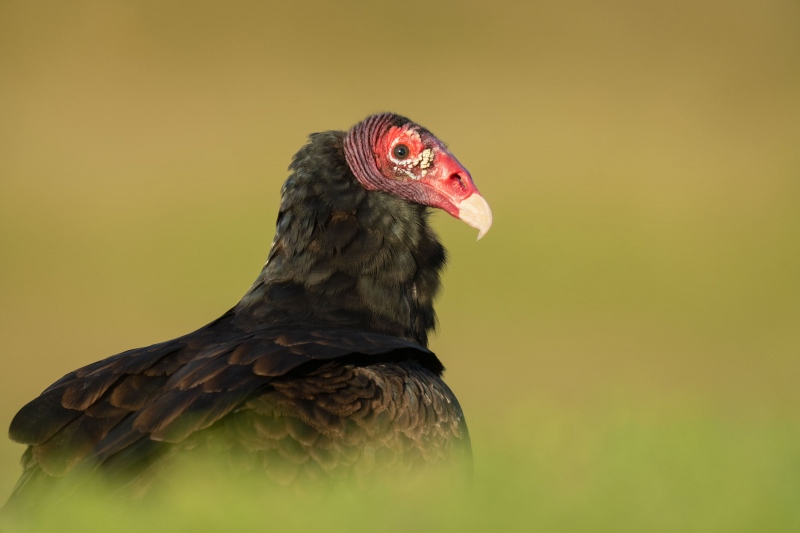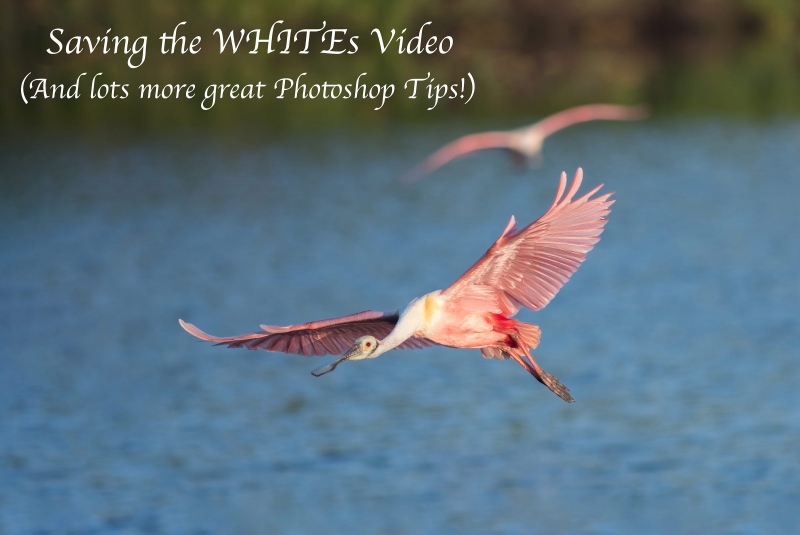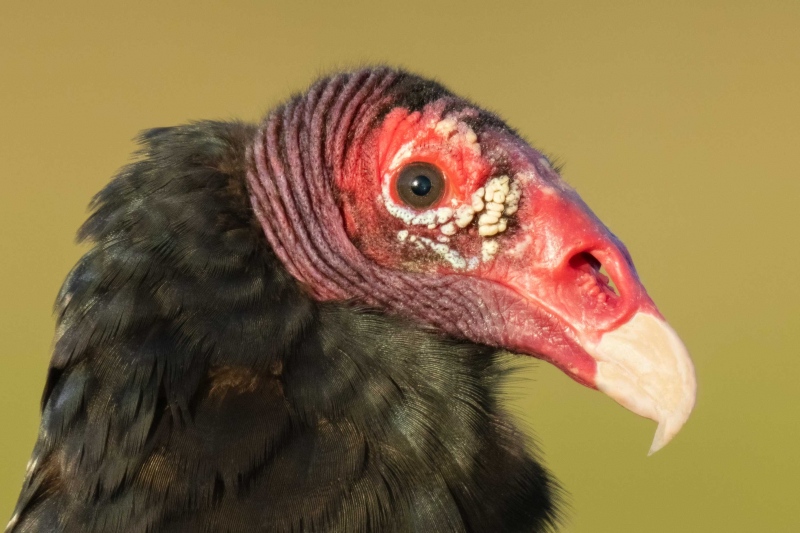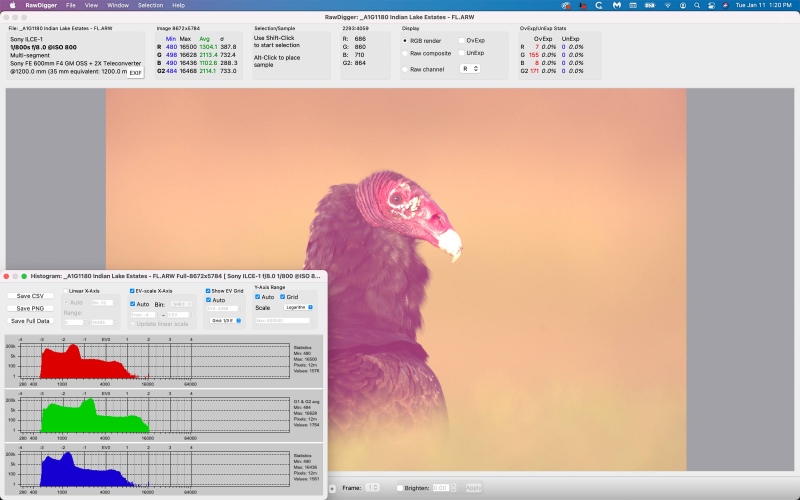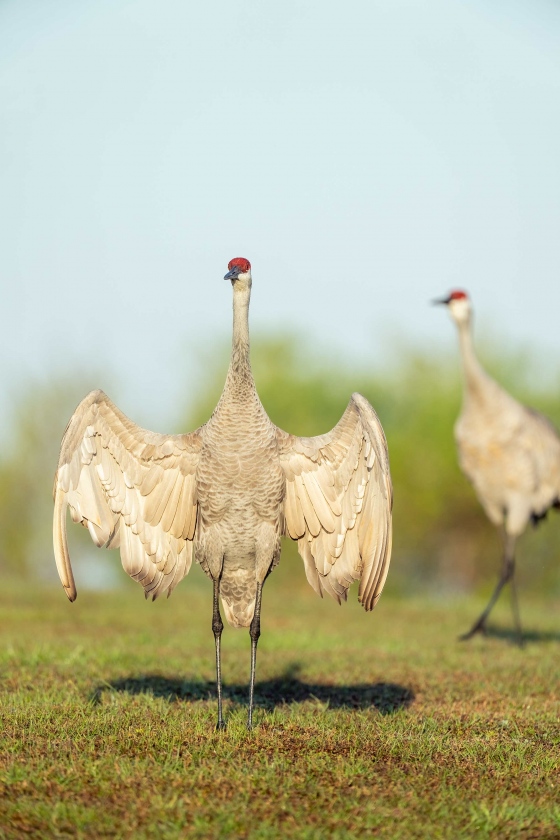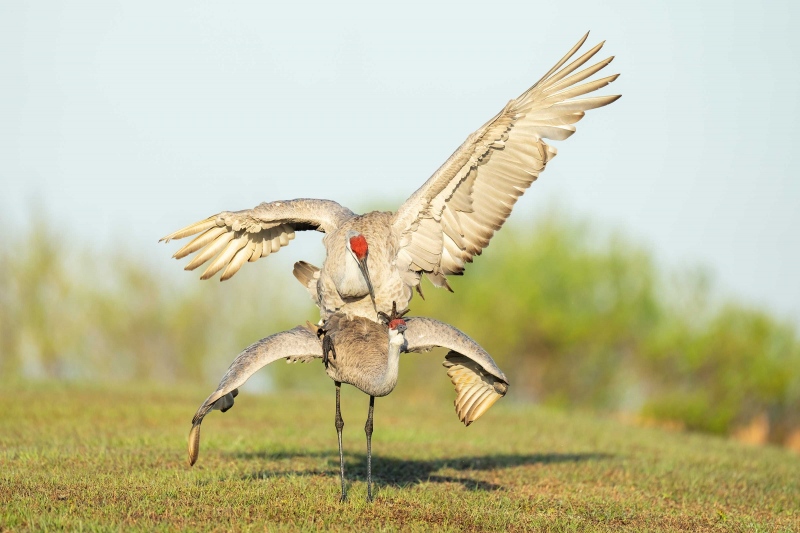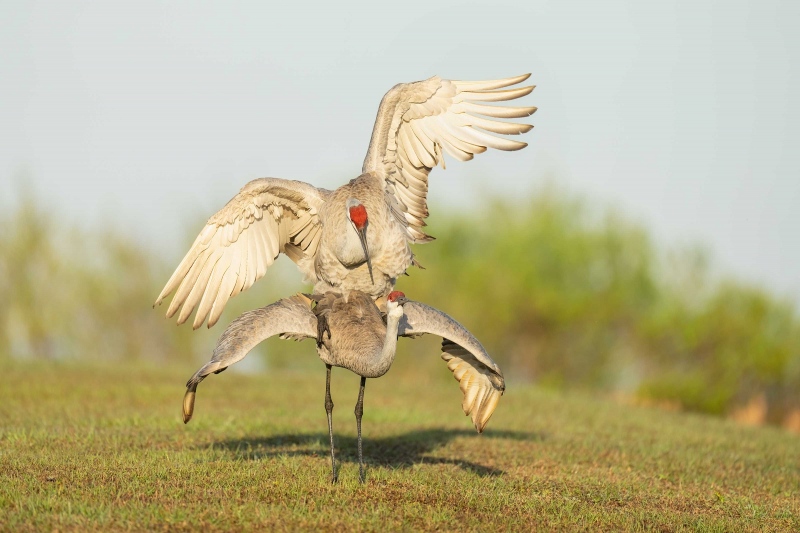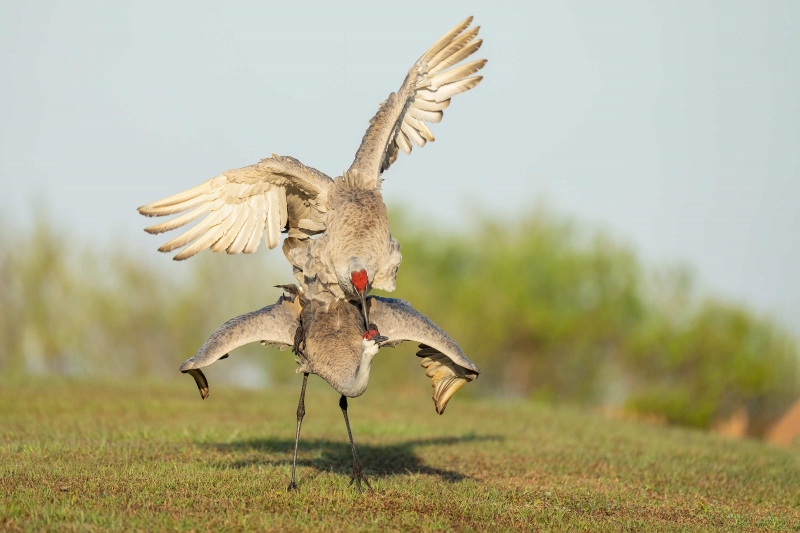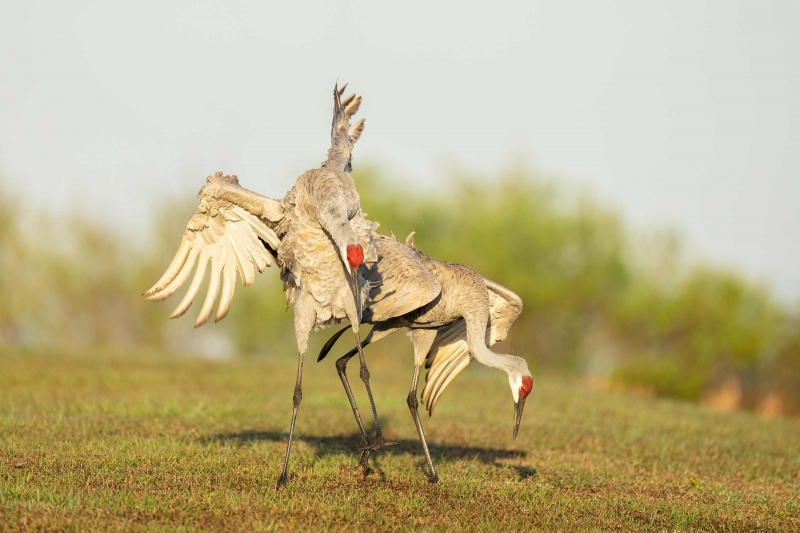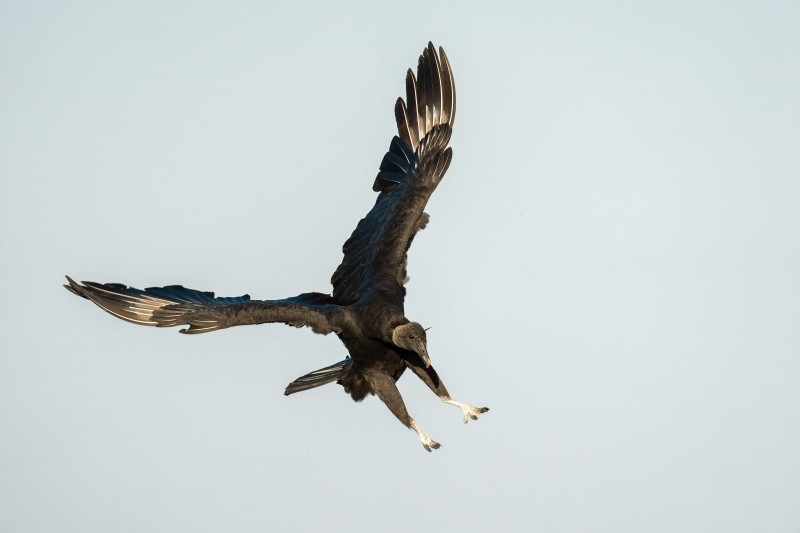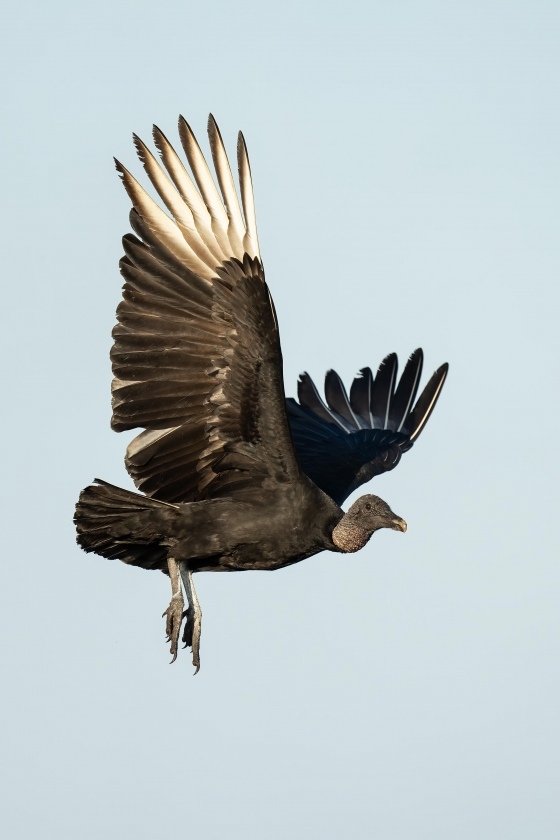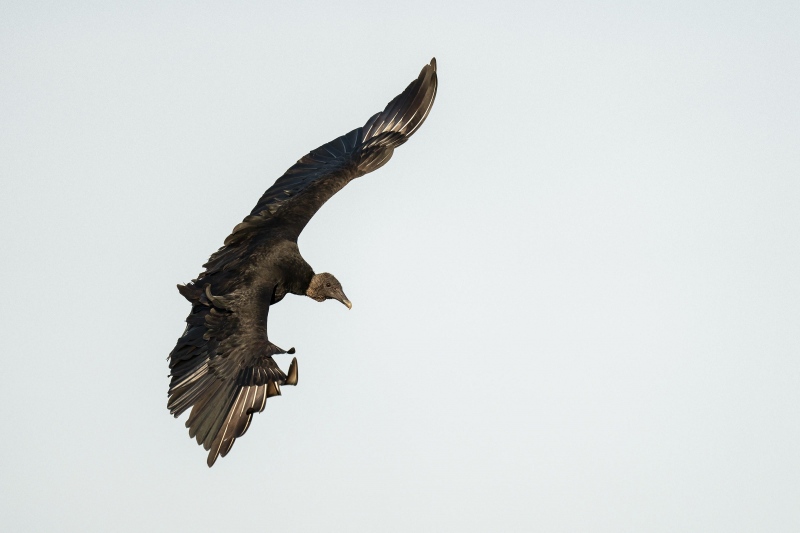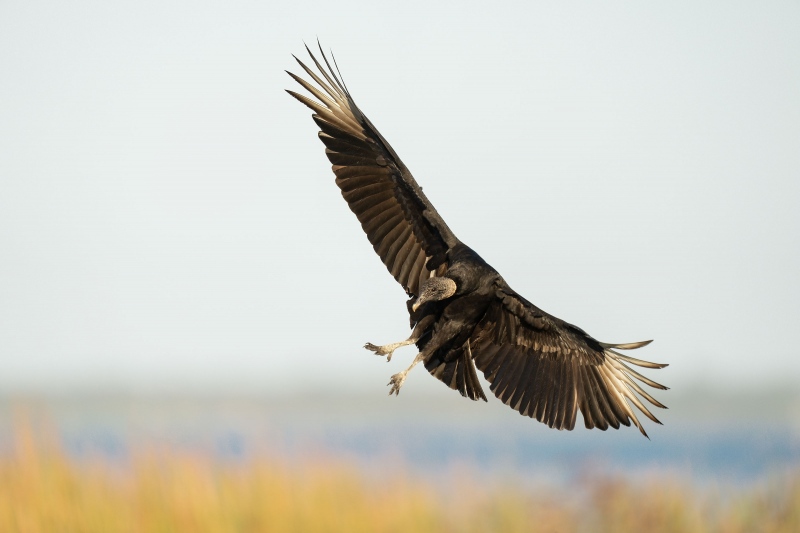January 12th, 2022 What’s Up?
The temperature at 7:00am on Tuesday here at ILE was 54°. With a brisk wind from the north by slightly west, it seemed like the coldest morning of the year (even though we had 48° about two weeks ago). IAC, once I was out on the pier, I walked back to the car to get my Emperor Penguin expedition parka. The day began with 201 blurs, all of those on a walk-around with the 200-600 G lens and an a1. I chased Turkey Vulture blurs while my big lens sat halfway out on the pier doing nothing at all. Once the sun came up, I had one very good chance with one very handsome TV on The Perch. Then more TVs on the knoll, and then the crane pair from yesterday’s blog post walked back up on the knoll! I prayed for a repeat copulation, but alas, that did not happen.
With a stiff north/northeast wind and some nice sky color, conditions at sunset were excellent. I think that I got some special White Ibis silhouettes.
Today is Wednesday 12 January 2022. The forecast for this morning is for partly cloudy with a light north/northeast wind. You can find me down by the lake early. Wherever you are, and whatever you are doing, I hope that you too have a great day. This blog post took more than 90 minutes to prepare and makes 63 consecutive days with a new one.
Please remember that you can find some great photo accessories (and necessities, like surf booties!) on Amazon by clicking on the Stuff tab on the orange/yellow menu bar above. On a related note, it would be extremely helpful if blog-folks who, like me, spend too much money on Amazon, would get in the habit of clicking on the Amazon logo link on the right side of each blog post when they shop online. As you might expect, doing so will not cost you a single penny, but would be appreciated tremendously by yours truly. And doing so works seamlessly with your Amazon Prime account.
Please remember that if an item — a Delkin flash card, or a tripod head — for example, that is available from B&H and/or Bedfords, is also available in the BAA Online Store, it would be great, and greatly appreciated, if you would opt to purchase from us. We will match any price. Please remember also to use my B&H affiliate links or to save 3% at Bedfords by using the BIRDSASART discount code at checkout for your major gear purchases. Doing either often earns you free guides and/or discounts. And always earns my great appreciation.
Sony Alpha 1 Bodies in Stock at Bedfords/free card offer!
Steve Elkins of Bedfords let me know recently that he had several Sony a1 bodies in stock. If one of them has your name on it, please click here and be sure to enter the BIRDSASART coupon code check the box for free shipping to enjoy free Second Day Air Fed-Ex. Right now, in lieu of the 3% credit refunded to the card you used for your purchase, you will receive a Sony 160GB CFexpress Type A TOUGH Memory Card, a $399.99 value!
Brand New and As-Good-As-Ever Bedfords BAA Discount Policy
Folks who have fallen in love with Bedfords can now use the BIRDSASART coupon code at checkout to enjoy a post-purchase, 3% off-statement credit (excluding taxes and shipping charges) on orders paid with a credit card. The 3% credit will be refunded to the card you used for your purchase. Be sure, also, to check the box for free shipping to enjoy free Second Day Air Fed-Ex. This offer does not apply to purchases of Classes, Gift Cards, or to any prior purchases.
Money Saving Reminder
Many have learned that if you need a hot photo item that is out of stock at B&H and would like to enjoy getting 3% back on your credit card along with free 2nd Day Air Fed-Ex Air shipping, your best bet is to click here, place an order with Bedfords, and enter the coupon code BIRDSASART at checkout. If an item is out of stock, contact Steve Elkins via e-mail or on his cell phone at (479) 381-2592 (Central time). Be sure to mention the BIRDSASART coupon code and check the box for Free Shipping. That will automatically upgrade to free 2nd Day Air Fed-Ex. Steve has been great at getting folks the hot items that are out of stock at B&H and everywhere else. The waitlists at the big stores can be a year or longer for the hard to get items. Steve will surely get you your gear long before that. For the past year, he has been helping BAA Blog folks get their hands on items like the SONY a 1, the SONY 200-600 G OSS lens, the Canon EOS R5, the Canon RF 100-500mm lens, and the Nikon 500mm PF. Steve is personable, helpful, and eager to please.
Important Note
As an Amazon Associate, I earn a small percentage when you purchase from Amazon after using any of the Amazon links on the blog (including the logo-link immediately above). My link works with Amazon Prime and using it will not cost you a single cent. Huge thanks, BTW 🙂
Please Remember Also
Please, if you enjoy and learn from the blog, remember to use one of my two affiliate programs when purchasing new gear. Doing so just might make it possible for me to avoid having to try to get a job as a Walmart greeter and will not cost you a single penny more. And if you use Bedfords and remember to enter the BIRDSASART code at checkout, you will (still!) save 3% on every order and enjoy free second-day air shipping. In these crazy times — I lost about fifty thousand dollars in income due to COVID 19 — remembering to use my B&H link or to shop at Bedfords will help me out a ton and be greatly appreciated. Overseas folks who cannot order from the US because of import fees, duties, and taxes, are invited to help out by clicking here to leave a blog thank you gift if they see fit.


Gear Questions and Advice
Too many folks attending BAA IPTs and dozens of photographers whom I see in the field and on BPN, are–out of ignorance–using the wrong gear, especially when it comes to tripods and more especially, tripod heads… Please know that I am always glad to answer your gear questions via e-mail. If you are desperate, you can try me on my cell at 863-221-2372. Please leave a message and shoot me a text if I do not pick up.
|
|
|
This image was created on 11 January 2022 down by the lake near my home in Indian Lake Estates. Working from the driver’s seat of my SUV, I used the BLUBB-supported Sony FE 600mm f/4 GM OSS lens, the Sony FE 2.0x Teleconverter, and The One, the Sony Alpha 1 Mirrorless Digital Camera.. ISO 800. The exposure was determined by Zebras with ISO on the rear wheel: 1/800 sec. at f/8 (wide open) in Manual mode. AWB at 8:32:13am on a sunny morning.
Tracking: Spot S AF/C with Bird-Eye/Face Detection performed perfectly. Click on the image to enjoy the high-res version.
Image #1: Turkey Vulture in suffused green heaven (1200mm)
|
How to Create Bird-in-Heaven Images
The trick to creating the bird-in-heaven look with a strip of out-of-focus color at the bottom of the frame is to find a situation where there is a small rise at least a few inches in front of the bird. When you focus on the bird, the foreground element, in this case the rise, will be rendered completely and pleasingly diffused. As the bird was on the far side of a small hill, the trick for me was to drive up the hill until I could see just the top half of the bird above the grass on the crest of the hill. Next, for this image, with the northwest wind, was getting the look-back head turn! I did that for this frame only and then the bird turned away from me and walked down the hill. One is all that it takes!
|
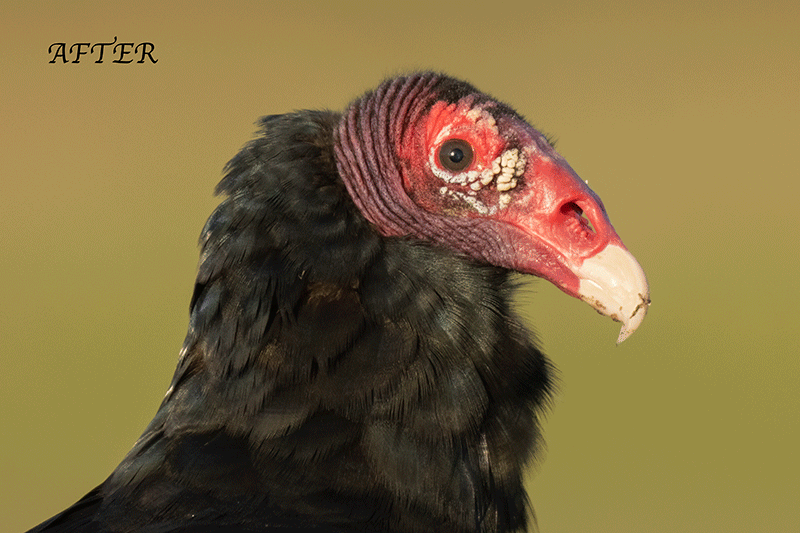
|
Image #1A: An Animated GIF showing the detail restored to the seemingly over-exposed bill tip
|
Before and After Saving the Whites
By exposing to the right to the max, you ensure getting maximum detail in the vulture’s dark and black feathers. Understand that the bill tip is not over-exposed — see the RawDigger screen capture at the bottom of this blog post. But while the bill is not over-exposed — the detail is all there in the digital file, we need to know how to restore that detail. The are several things to do in the raw conversion, and many additional steps to be done once the .TIF file is in Photoshop (or in Lightroom). You rarely need to use all of the techniques on a single image, but it surely helps to have them all at your disposal. All of them are detailed in the Saving the Whites (and lots more!) Video.
|
|
The Saving the WHITEs (and lots more!) Video image
|
The Saving the Whites (and lots more!) Video
My two biggest challenges when optimizing images are getting the BLUEs just right, and restoring detail to the WHITEs and highlights of properly exposed raw files. There are four things that I do to accomplish the latter. All are covered in detail in this 21+ minute video, along with a dirty trick to try if the first four do not work perfectly. Sit with me at my laptop as I teach you how to save the WHITEs. I begin with the raw conversions of two different raw files, first with the Snowy Owl image featured here, and then with Joe Usewicz’s spoonbill image that was featured in the Extraordinary Over-Exposed (?) Spoonbill/Saving the WHITEs Optimization blog post here.
In addition to learning how to save the WHITEs (in both images), you will learn how to expand canvas using the amazingly convenient Content-Aware Crop Tool, to set the White Balance (color temperature), to set the WHITE and BLACK points, see Digital Eye Doctor and RawDigger in action, learn to make a Color Range Selection, and lots more.
To purchase your copy of the Saving the Whites Video (and lots more!) video, you can send a PayPal for $37.00 to us at birdsasart@verizon.net, call Jim in the office at 863-692-0906 with your credit card in hand, or visit the item in the BAA Online store by clicking here.
|
|
Image #1C: Tight crop of the face of the Turkey Vulture in suffused green heaven (1200mm)
|
Amazing Sharpness and Detail at 1200mm
I continue to be stunned by the sharpness, image quality, and fine-feather detail of Sony Alpha 1 images, even those created at 1200mm. Even when working off the BLUBB. Note: while the BLUBB is by far the most stable beanbag ever created, a good tripod and head will always be a bit more stable. But not anywhere as convenient when using your car as a blind.
|
|
Image #1A: RawDigger screen capture for the Turkey Vulture in suffused green heaven (1200mm) image
|
Dead-Solid Perfect!
Images where the G channel gets 2/3rds of the way from the 8000 to the 16000 line are perfect exposures. Images where the G channel gets right up to the line are dead-solid perfect. With 341 Ov-Exp pixels out of 51,000,000 this is a dead-solid perfect exposure. Note: if you magnify the image you can see that all of the Ov-Exp pixels are in the specular highlight in the bird’s eye.
RawDigger — not for the faint of heart …
Nothing has ever helped me learn to create perfect exposures to the degree that RawDigger has. I think that many folks are reluctant to learn that most of their images are underexposed by one or more full stops and that highlight warnings in Photoshop, Lightroom, Capture One, and your in-camera histogram are completely bogus as they are based on the embedded JPEGs. Only your raw files tell the truth all the time. Heck, I resisted RawDigger for several years … Once you get over that feeling, RawDigger can become your very best exposure friend no matter what system you are using. On the recent IPTs and In-the-Field sessions, we have demonstrated that fact. Convincingly.
The RawDigger (pink) Adapted Histogram
In the RawDigger e-Guide, you will learn exactly how to set up the Adapted “pink” RawDigger Histogram and how to use it to quickly and easily evaluate the exposure or raw file brightness of images from all digital cameras currently in use. RawDigger was especially helpful to me when I struggled with R5 exposures and when I learned my new camera body, the Sony Alpha a1.
|
|
RawDigger e-Guide with Two Videos
|
The RawDigger e-Guide with Two Videos
by Arthur Morris with Patrick Sparkman
The RawDigger e-Guide was created only for serious photographers who wish to get the absolute most out of their raw files.
Patrick and I began work on the guide in July 2020. At first, we struggled. We asked questions. We learned about Max-G values. We could not figure out why the Max G values varied by camera system. IPT veteran Bart Deamer asked lots of questions that we could not answer. We got help from RawDigger creator Iliah Borg. We learned. In December, Patrick came up with an Adapted Histogram that allows us to evaluate the exposures and raw file brightness for all images created with all digital camera bodies from the last two decades. What we learned each time prompted three complete beginning-to-end re-writes.
The point of the guide is to teach you to truly expose to the mega-Expose-to-the-Right so that you will minimize noise, maximize image quality, best utilize your camera’s dynamic range, and attain the highest possible level of shadow detail in your RAW files in every situation. In addition, your properly exposed RAW files will contain more tonal information and feature the smoothest possible transitions between tones. And your optimized images will feature rich, accurate colors.
We teach you why the GREEN channel is almost always the first to over-expose. We save you money by advising you as to which version of RawDigger you need. We teach you how to interpret the Max G values for your Canon, Nikon, and SONY camera bodies. It is very likely that the Shock-your-World section will shock you. And lastly — thanks to the technical and practical brilliance of Patrick Sparkman — we teach you a simple way to quickly and easily evaluate your exposures and raw file brightness using an Adapted RawDigger histogram.
The flower video takes you through a session where artie edits a folder of images in Capture One while checking the exposures and Max-G values in RawDigger. The Adapted Histogram video examines a series of recent images with the pink histograms and covers lots of fine points including and especially how to deal with specular highlights. The directions for setting up the Adapted Histogram are in the text.
If we priced this guide based on how much effort we put into it, it would sell it for $999.00. But as this guide will be purchased only by a limited number of serious photographers, we have priced it at $51.00. You can order yours here in the BAA Online Store.
Typos
With all blog posts, feel free to e-mail or to leave a comment regarding any typos or errors.
January 11th, 2022 Which is the Best Image?
All are invited to leave a comment letting us know which of today’s six featured images they like best, and why they made their choice.
Thanks for all the comments on the Black Vulture images in yesterday’s blog post. The consensus pick was Image #4 with the interesting background. My pick was Image #2, the vertical with the somewhat crazy flight pose.
What’s Up?
On Monday morning, I enjoyed another great photo session at ILE. It began on the pier with 321 blurs. Those included eight keepers after the first edit. I took a few snaps of the eagle before and after the sun hit the nest. I am pretty sure, but not positive, that the bird was feeding a chick … Next up was a Cattle Egret on a piling at the boat ramp dock in super-sweet early morning butter light. I kept nine of 96. Each featured a lovely green background. When something spooked the egret, I followed the movement and I saw three Killdeer on the boat ramp in the shade of my SUV. Two of them bathed. In just 2 minutes 18 seconds, I created 269 images; 23 of those survived the first cut. Then I drove to the parking circle to check out The Perch. On the way, I saw two cranes atop the small knoll just to the north. I positioned the car on sun angle and working off the BLUBB, I made a bunch of ordinary images at 840mm with the 600mm f/4, the 1.4X TC, and the a1. Then things got really exciting. In all, I created 482 images of the cranes on the rise. Keep reading below to learn what happened next.
Sunset on Monday was another cloudy bust. Today is Tuesday 11 January 2022. Clearing skies with a north wind are in the forecast. I will get down to the lake for at least a while. Wherever you are, and whatever you are doing, I hope that you too have a great day. This blog post took more than three hours to prepare (including the time spent on the six image optimizations) and makes 62 consecutive days with a new one.
Please remember that you can find some great photo accessories (and necessities, like surf booties!) on Amazon by clicking on the Stuff tab on the orange/yellow menu bar above. On a related note, it would be extremely helpful if blog-folks who, like me, spend too much money on Amazon, would get in the habit of clicking on the Amazon logo link on the right side of each blog post when they shop online. As you might expect, doing so will not cost you a single penny, but would be appreciated tremendously by yours truly. And doing so works seamlessly with your Amazon Prime account.
Please remember that if an item — a Delkin flash card, or a tripod head — for example, that is available from B&H and/or Bedfords, is also available in the BAA Online Store, it would be great, and greatly appreciated, if you would opt to purchase from us. We will match any price. Please remember also to use my B&H affiliate links or to save 3% at Bedfords by using the BIRDSASART discount code at checkout for your major gear purchases. Doing either often earns you free guides and/or discounts. And always earns my great appreciation.
Sony Alpha 1 Bodies in Stock at Bedfords/free card offer!
Steve Elkins of Bedfords let me know recently that he had several Sony a1 bodies in stock. If one of them has your name on it, please click here and be sure to enter the BIRDSASART coupon code check the box for free shipping to enjoy free Second Day Air Fed-Ex. Right now, in lieu of the 3% credit refunded to the card you used for your purchase, you will receive a Sony 160GB CFexpress Type A TOUGH Memory Card, a $399.99 value!
Brand New and As-Good-As-Ever Bedfords BAA Discount Policy
Folks who have fallen in love with Bedfords can now use the BIRDSASART coupon code at checkout to enjoy a post-purchase, 3% off-statement credit (excluding taxes and shipping charges) on orders paid with a credit card. The 3% credit will be refunded to the card you used for your purchase. Be sure, also, to check the box for free shipping to enjoy free Second Day Air Fed-Ex. This offer does not apply to purchases of Classes, Gift Cards, or to any prior purchases.
Money Saving Reminder
Many have learned that if you need a hot photo item that is out of stock at B&H and would like to enjoy getting 3% back on your credit card along with free 2nd Day Air Fed-Ex Air shipping, your best bet is to click here, place an order with Bedfords, and enter the coupon code BIRDSASART at checkout. If an item is out of stock, contact Steve Elkins via e-mail or on his cell phone at (479) 381-2592 (Central time). Be sure to mention the BIRDSASART coupon code and check the box for Free Shipping. That will automatically upgrade to free 2nd Day Air Fed-Ex. Steve has been great at getting folks the hot items that are out of stock at B&H and everywhere else. The waitlists at the big stores can be a year or longer for the hard to get items. Steve will surely get you your gear long before that. For the past year, he has been helping BAA Blog folks get their hands on items like the SONY a 1, the SONY 200-600 G OSS lens, the Canon EOS R5, the Canon RF 100-500mm lens, and the Nikon 500mm PF. Steve is personable, helpful, and eager to please.
Important Note
As an Amazon Associate, I earn a small percentage when you purchase from Amazon after using any of the Amazon links on the blog (including the logo-link immediately above). My link works with Amazon Prime and using it will not cost you a single cent. Huge thanks, BTW 🙂
Please Remember Also
Please, if you enjoy and learn from the blog, remember to use one of my two affiliate programs when purchasing new gear. Doing so just might make it possible for me to avoid having to try to get a job as a Walmart greeter and will not cost you a single penny more. And if you use Bedfords and remember to enter the BIRDSASART code at checkout, you will (still!) save 3% on every order and enjoy free second-day air shipping. In these crazy times — I lost about fifty thousand dollars in income due to COVID 19 — remembering to use my B&H link or to shop at Bedfords will help me out a ton and be greatly appreciated. Overseas folks who cannot order from the US because of import fees, duties, and taxes, are invited to help out by clicking here to leave a blog thank you gift if they see fit.


Gear Questions and Advice
Too many folks attending BAA IPTs and dozens of photographers whom I see in the field and on BPN, are–out of ignorance–using the wrong gear, especially when it comes to tripods and more especially, tripod heads… Please know that I am always glad to answer your gear questions via e-mail. If you are desperate, you can try me on my cell at 863-221-2372. Please leave a message and shoot me a text if I do not pick up.
|
|
|
This image was created on 10 January 2022 at Indian Lake Estates. Working from the front seat of my SUV, I used the BLUBB-supported Sony FE 600mm f/4 GM OSS lens with the Sony FE 1.4x Teleconverter, and The One, the Sony Alpha 1 Mirrorless Digital Camera). ISO 800. The exposure was determined using Zebra technology with ISO on the rear wheel: 1/1250 sec. at f/5.6 (wide open) in Manual mode. AWB at 8:06:41am on a mostly sunny morning.
Tracking: Spot S AF-C performed perfectly. Be sure to click on the image to enjoy a higher-res version.
Image #1: Sandhill Crane female inviting copulation
|
The Invitation
The two cranes began walking down the back side of the small hill. One of them leaned forward, almost as if bowing. This indicates one of two things:
A- The bird is about to take flight
B- The female is beginning a sequence of behaviors inviting the male to copulate.
In this case it was B. The bird that had leaned forward had been the female. She walked toward me and spread her wings low and to the side as you see in Image #1. This was a clear invitation to the male to copulate. I was vertical at 840mm. The moment that I saw the male walking up behind the female, I knew that he had accepted. Even as I made a few images, I knew that I would need to remove the teleconverter and switch from vertical to horizontal ASAP to avoid clipping wings and more.
|
|
|
This image was created on 10 January 2022 at Indian Lake Estates. Working from the front seat of my SUV, I used the BLUBB-supported Sony FE 600mm f/4 GM OSS lens and The One, the Sony Alpha 1 Mirrorless Digital Camera). ISO 800. The exposure was determined using Zebra technology with ISO on the rear wheel: 1/2000 sec. at f/4 (wide open) in Manual mode. AWB at 8:06:58am on a mostly sunny morning.
AF Method unknown, but whatever it was, it performed amazingly well. Be sure to click on the image to enjoy a higher-res version.
Image #2: Sandhill Crane pair copulating, male with foot raised over female’s head
|
The Good News and the Bad News
Faced with a rapidly-developing, pretty-much-perfect situation, my heart was pounding. You might think it strange that after 38 years of bird photography I could still get so excited. It took me 16 seconds to remove the TC, remount the camera body, turn the lens to horizontal on the BLUBB, and adjust the exposure (albeit incorrectly). During the time that it had taken me to remove the TC, the male had mounted the female. I noted way too many Zebras, so I increased the shutter speed. But I increased it only two clicks from 1/1250 sec. to 1/2000 sec. As the aperture went from f/5.6 to f/4 when I removed the TC, I should have gone three clicks to 1/2500 sec. As a result of this error, all of the raw files were over-exposed to varying degrees, some by as much as 1/3 stop. The over-exposures were all in the bright tones of the under-primary feathers. I used the knowledge gained from working with RawDigger for the past three years — all of the Ov-Exp pixels were in the G channel — and the techniques detailed in the Saving the Whites Video to successfully process the six images featured here today.
|
|
|
This image was created on 10 January 2022 at Indian Lake Estates. Working from the front seat of my SUV, I used the BLUBB-supported Sony FE 600mm f/4 GM OSS lens and The One, the Sony Alpha 1 Mirrorless Digital Camera). ISO 800. The exposure was determined using Zebra technology with ISO on the rear wheel: 1/2000 sec. at f/4 (wide open) in Manual mode. AWB at 8:06:58am on a mostly sunny morning.
AF Method unknown, but whatever it was, it performed amazingly well. Be sure to click on the image to enjoy a higher-res version.
Image #3: Sandhill Crane pair copulating
|
Pedal to the Metal
Because I had to remove the TC, I was a bit late to the party. From there, it was all over in less than four seconds. I do not remember releasing pressure on the shutter button. There were 87 images in the sequence. I opted to keep only 13. I clipped a wing in only two images; all the rest were quite excellent. But you simply cannot keep all the good ones with the a1.
Note: Images #2-5 are all quite similar, but there are small differences in each photo the led me to keep this or that image and to discard many others. The determining factors had to do primarily with differing head and wing (and even foot) positions, mostly with respect to the male bird, the one on top 🙂
|
|
|
This image was created on 10 January 2022 at Indian Lake Estates. Working from the front seat of my SUV, I used the BLUBB-supported Sony FE 600mm f/4 GM OSS lens and The One, the Sony Alpha 1 Mirrorless Digital Camera). ISO 800. The exposure was determined using Zebra technology with ISO on the rear wheel: 1/2000 sec. at f/4 (wide open) in Manual mode. AWB at 8:06:59am on a mostly sunny morning.
AF Method unknown, but whatever it was, it performed amazingly well. Be sure to click on the image to enjoy a higher-res version.
Image #4: Sandhill Crane pair copulating, male’s wings raised for balance
|
AF Method
AF Method unknown, but whatever it was, it performed amazingly well.
On my gripped a1, I have three AF Methods enabled. But only two are enabled on my other a1. With the camera set up properly, the camera remembers both the AF Method and the position of the point or zone when you switch from vertical to horizontal. I am 100% sure that for Image #1, the vertical, I was using Tracking: Spot S. But in all the excitement, I am not sure if I was using that or Tracking: Zone. But it did not matter: every one of the 87 images in the copulation series was sharp.
|
|
|
This image was created on 10 January 2022 at Indian Lake Estates. Working from the front seat of my SUV, I used the BLUBB-supported Sony FE 600mm f/4 GM OSS lens and The One, the Sony Alpha 1 Mirrorless Digital Camera). ISO 800. The exposure was determined using Zebra technology with ISO on the rear wheel: 1/2500 sec. at f/4 (wide open) in Manual mode. AWB at 8:07:01am on a mostly sunny morning.
AF Method unknown, but whatever it was, it performed amazingly well. Be sure to click on the image to enjoy a higher-res version.
Image #5: Sandhill Crane pair copulating, male biting head of female
|
More Fine-Feather Detail?
After clicking on each image to view the high-res version, please leave a comment if you think that one of today’s images shows more fine-feather detail than the other five. If yes, which one. If they all look the same to you, you are invited to leave a comment stating that. Your answer will help me out quite a bit.
|
|
|
This image was created on 10 January 2022 at Indian Lake Estates. Working from the front seat of my SUV, I used the BLUBB-supported Sony FE 600mm f/4 GM OSS lens and The One, the Sony Alpha 1 Mirrorless Digital Camera). ISO 800. The exposure was determined using Zebra technology with ISO on the rear wheel: 1/2500 sec. at f/4 (wide open) in Manual mode. AWB at 8:07:01am on a mostly sunny morning.
AF Method unknown, but whatever it was, it performed amazingly well. Be sure to click on the image to enjoy a higher-res version.
Image #6: Sandhill Crane pair copulating, male dismounting
|
The Dismount
All good things must come to an end. To dismount, the male stepped over its mate. Less than five minutes after driving away from the knoll, I was about five seconds too late another pair of cranes copulated on the South Peninsula. Let’s hope that there are lots of crane chicks this season.
|
|
The Saving the WHITEs (and lots more!) Video image
|
The Saving the Whites (and lots more!) Video
My two biggest challenges when optimizing images are getting the BLUEs just right, and restoring detail to the WHITEs and highlights of properly exposed raw files. There are four things that I do to accomplish the latter. All are covered in detail in this 21+ minute video, along with a dirty trick to try if the first four do not work perfectly. Sit with me at my laptop as I teach you how to save the WHITEs. I begin with the raw conversions of two different raw files, today’s featured Snowy Owl image, and Joe Usewicz’s spoonbill image that was featured in the Extraordinary Over-Exposed (?) Spoonbill/Saving the WHITEs Optimization blog post here.
In addition to learning how to save the WHITEs (in both images), you will learn how to expand canvas using the amazingly convenient Content-Aware Crop Tool, to set the White Balance (color temperature), to set the WHITE and BLACK points, see Digital Eye Doctor and RawDigger in action, learn to make a Color Range Selection, and lots more.
To purchase your copy of the Saving the Whites Video (and lots more!) video, you can send a PayPal for $37.00 to us at birdsasart@verizon.net, call Jim in the office at 863-692-0906 with your credit card in hand, or visit the item in the BAA Online store by clicking here.
After clicking on each image, check out the nice detail in the white face of the owl in the optimized version (Image #1), with the virtually absent detail in the face of the owl in the Photo Mechanic screen capture (Image #1A). As I have been saying here often for two decades, properly exposed raw files will often appear washed out with little detail in the highlights …
Typos
With all blog posts, feel free to e-mail or to leave a comment regarding any typos or errors.
January 10th, 2022 The Best?
Which of today’s four featured images do you think is the best? Please leave a comment letting know why you made your choice. (Though I love all of them, I will share my clear favorite with you here fairly soon).
What’s Up?
After the stellar photo session at sunset on Saturday, I fully expected to be sharing some wading bird silhouettes with you here today, but Sunday morning was even more phenomenal. With clear skies and a fairly brisk wind from the east/northeast, conditions were perfect for setting out a road kill cafe. So I did. Be sure to click on each Black Vulture image to better note the sharpness and fine detail in each of the larger, high-res versions. And the flight poses are not bad either!
It was totally cloudy on Sunday afternoon and early evening. With no chance of sunset, I stayed home and watched football. Amazingly, I had enjoyed 15 consecutive decent sunsets going back to Christmas Eve. As usual, I have been quite blessed.
Today is Monday 10 January 2022. The forecast for this morning is for cloudy and still. You know where I will be early. Wherever you are, and whatever you are doing, I hope that you too have a great day. This blog post took about 90 minutes to prepare including the time spent on the four image optimizations and makes 61 consecutive days with a new one.
Please remember that you can find some great photo accessories (and necessities, like surf booties!) on Amazon by clicking on the Stuff tab on the orange/yellow menu bar above. On a related note, it would be extremely helpful if blog-folks who, like me, spend too much money on Amazon, would get in the habit of clicking on the Amazon logo link on the right side of each blog post when they shop online. As you might expect, doing so will not cost you a single penny, but would be appreciated tremendously by yours truly. And doing so works seamlessly with your Amazon Prime account.
Please remember that if an item — a Delkin flash card, or a tripod head — for example, that is available from B&H and/or Bedfords, is also available in the BAA Online Store, it would be great, and greatly appreciated, if you would opt to purchase from us. We will match any price. Please remember also to use my B&H affiliate links or to save 3% at Bedfords by using the BIRDSASART discount code at checkout for your major gear purchases. Doing either often earns you free guides and/or discounts. And always earns my great appreciation.
Sony Alpha 1 Bodies in Stock at Bedfords/free card offer!
Steve Elkins of Bedfords let me know recently that he had several Sony a1 bodies in stock. If one of them has your name on it, please click here and be sure to enter the BIRDSASART coupon code check the box for free shipping to enjoy free Second Day Air Fed-Ex. Right now, in lieu of the 3% credit refunded to the card you used for your purchase, you will receive a Sony 160GB CFexpress Type A TOUGH Memory Card, a $399.99 value!
Brand New and As-Good-As-Ever Bedfords BAA Discount Policy
Folks who have fallen in love with Bedfords can now use the BIRDSASART coupon code at checkout to enjoy a post-purchase, 3% off-statement credit (excluding taxes and shipping charges) on orders paid with a credit card. The 3% credit will be refunded to the card you used for your purchase. Be sure, also, to check the box for free shipping to enjoy free Second Day Air Fed-Ex. This offer does not apply to purchases of Classes, Gift Cards, or to any prior purchases.
Money Saving Reminder
Many have learned that if you need a hot photo item that is out of stock at B&H and would like to enjoy getting 3% back on your credit card along with free 2nd Day Air Fed-Ex Air shipping, your best bet is to click here, place an order with Bedfords, and enter the coupon code BIRDSASART at checkout. If an item is out of stock, contact Steve Elkins via e-mail or on his cell phone at (479) 381-2592 (Central time). Be sure to mention the BIRDSASART coupon code and check the box for Free Shipping. That will automatically upgrade to free 2nd Day Air Fed-Ex. Steve has been great at getting folks the hot items that are out of stock at B&H and everywhere else. The waitlists at the big stores can be a year or longer for the hard to get items. Steve will surely get you your gear long before that. For the past year, he has been helping BAA Blog folks get their hands on items like the SONY a 1, the SONY 200-600 G OSS lens, the Canon EOS R5, the Canon RF 100-500mm lens, and the Nikon 500mm PF. Steve is personable, helpful, and eager to please.
Important Note
As an Amazon Associate, I earn a small percentage when you purchase from Amazon after using any of the Amazon links on the blog (including the logo-link immediately above). My link works with Amazon Prime and using it will not cost you a single cent. Huge thanks, BTW 🙂
Please Remember Also
Please, if you enjoy and learn from the blog, remember to use one of my two affiliate programs when purchasing new gear. Doing so just might make it possible for me to avoid having to try to get a job as a Walmart greeter and will not cost you a single penny more. And if you use Bedfords and remember to enter the BIRDSASART code at checkout, you will (still!) save 3% on every order and enjoy free second-day air shipping. In these crazy times — I lost about fifty thousand dollars in income due to COVID 19 — remembering to use my B&H link or to shop at Bedfords will help me out a ton and be greatly appreciated. Overseas folks who cannot order from the US because of import fees, duties, and taxes, are invited to help out by clicking here to leave a blog thank you gift if they see fit.


Gear Questions and Advice
Too many folks attending BAA IPTs and dozens of photographers whom I see in the field and on BPN, are–out of ignorance–using the wrong gear, especially when it comes to tripods and more especially, tripod heads… Please know that I am always glad to answer your gear questions via e-mail. If you are desperate, you can try me on my cell at 863-221-2372. Please leave a message and shoot me a text if I do not pick up.
|
|
|
This image was created on 9 January 2022 down by the lake at Indian Lake Estates. Standing at full height down by the edge of the canal put me just about eye level with the birds on the ground. I used the no-longer-available Induro GIT 304L/Levered-Clamp FlexShooter Pro-mounted Sony FE 600mm f/4 GM OSS lens and The One, the Sony Alpha 1 Mirrorless Digital Camera). IS 800. The exposure was determined via Zebras with ISO on the rear wheel: 1/3200 sec. at f/4 (wide open) in Manual mode. AWB at 8:15:42am on a mostly sunny morning.
Tracking: Spot S AF-C performed very well. Be sure to click on the image to enjoy a higher-res version.
Image #1: Black Vulture feet out-stretched for landing
|
The Road Kill Cafe
Saturday’s road kill cafe consisted of the fresh rabbit that I picked up on Park Drive last Thursday and the carcasses of six small Red Snappers that had been filleted by Mike at Junior’s Fish Store in Lake Wales. After shooting a spot that would yield pleasing backgrounds, First, I set up the tripod down by the canal and mounted my rig on it. As always, I made sure to seat the tripod firmly in the damp soil and then leveled the silver ball of the Levered-Clamp FlexShooter Pro by centering the bubble in the scribed circle. Then I rotated the lens in the lens barrel to the horizontal click stop with the electronic level activated. That done, the lens could be pointed in any direction and produce square-to-the-world images.
Then I repositioned my SUV so that I could get some work down on the laptop and shoot from the driver’s seat with the 200-600 G lens/a1 rig (if necessary). I was in the process of plugging in my MacBook Pro so that I could start consolidating the 26 SONY Alpha a1 Set-up and Info Notes e-mails into two user-friendly files. I glanced out the window and saw a Turkey Vulture voraciously chowing down on the rabbit. As I risked scaring the bird away, I opened the door very slowly and did the same as I moved down the slope to my tripod-mounted lens.
Then more vultures flew in. And more. And more. The rabbit was devoured in less than five minutes! But with a good supply of fish carcasses, the birds kept coming. At one point, I counted more than 100 vultures on the ground. Two of the locally-nesting birds got in on the action as a Bald Eagle and a Crested Caracara landed at the fray. The action lasted about 45 minutes. There were still a few birds flying in when I left at 8:45am just after it began to cloud up.
|
|
|
This image was created on 9 January 2022 down by the lake at Indian Lake Estates. Standing at full height down by the edge of the canal put me just about eye level with the birds on the ground. I used the no-longer-available Induro GIT 304L/Levered-Clamp FlexShooter Pro-mounted Sony FE 600mm f/4 GM OSS lens and The One, the Sony Alpha 1 Mirrorless Digital Camera). IS) 640. The exposure was determined via Zebras with ISO on the rear wheel: 1/3200 sec. at f/4 (wide open) in Manual mode. AWB at 8:21:30am on a mostly sunny morning.
Tracking: Spot S AF-C performed very well. Be sure to click on the image to enjoy a higher-res version.
Image #2: Black Vulture turning in flight while being chased
|
The Cast of Characters
First to dine was a single Turkey Vulture (TV). Most of the early arrivals were TVs. Then the Black Vultures (BVs) began to fly in to feast. Because the birds fly so differently, nearly all of my best images were of BVs. The TVs flap slowly and teeter-totter in flight often circling before landing. And when they do land, they tend to land behind the mass of birds and — being a bit shyer than the BVs, on the slope that leads down to the lake. Thus, their feet and lower bodies are often obscured. The BVs fly much more directly. The ones that approached from the east, from somewhere behind me, would come in and fast and hard and then turn to land into the wind. This gave me lots of chances to create images featuring some really neat wing positions and flight postures. At times, the action was beyond frantic with birds coming in three, four, five, and even six at a time. All in all, it was the best-ever Black Vulture flight photography session. With the results to prove it.
Had there been an east wind forecast for this morning, I would have defrosted the raccoon that has been resting in the freezer for several months …
Note
Image #2 was created from a horizontal original. I executed a 2X3 crop and in the process, added just a bit of blue sky canvas using the Content-Aware Crop Tool.
|
|
|
This image was created on 9 January 2022 down by the lake at Indian Lake Estates. Standing at full height down by the edge of the canal put me just about eye level with the birds on the ground. I used the no-longer-available Induro GIT 304L/Levered-Clamp FlexShooter Pro-mounted Sony FE 600mm f/4 GM OSS lens and The One, the Sony Alpha 1 Mirrorless Digital Camera). IS) 800. The exposure was determined via Zebras with ISO on the rear wheel: 1/3200 sec. at f/4 (wide open) in Manual mode. AWB at 8:29:45am on a mostly sunny morning.
Tracking: Spot S AF-C performed very well. Be sure to click on the image to enjoy a higher-res version.
Image #3: Black Vulture incoming flight/dorsal view
|
Sony a1 AF System Learning
Careful regular readers may note that on Sunday, I began experimenting with a different AF Method for flight photography. I was thrilled by what I learned. I will be sharing the how, the what, the why, and the when with the folks in the SONY Alpha a1 Set-up and Info Notes group this week via e-mail.
|
|
|
This image was created on 9 January 2022 down by the lake at Indian Lake Estates. Standing at full height down by the edge of the canal put me just about eye level with the birds on the ground. I used the no-longer-available Induro GIT 304L/Levered-Clamp FlexShooter Pro-mounted Sony FE 600mm f/4 GM OSS lens and The One, the Sony Alpha 1 Mirrorless Digital Camera). IS) 800. The exposure was determined via Zebras with ISO on the rear wheel: 1/3200 sec. at f/4 (wide open) in Manual mode. AWB at 8:31:51am on a mostly sunny morning.
Tracking: Spot S AF-C performed very well. Be sure to click on the image to enjoy a higher-res version.
Image #4: Black Vulture braking to land
|
Learning About Flight Photography
As you view each flight image, consider the wing position and the flight pose. Note the even lighting. Note the position and the visibility of the vulture’s heads. And note that the feet play an important role in the success of three of today’s four images.
With Image #4, I love the inclusion of the marsh and a bit of the lake in the frame.
SONY Alpha a1 Set-up and Info Group
The SONY Alpha a1 Set-up and Info Group is going great guns as more and more folks chime in with thoughtful questions and experience-based answers. As the a1 is becoming more readily available, more and more folks are getting their hands on this amazing body. This week, two folks in the group ordered their third a1! I am envious. The group is now up to an astounding 102 lucky and blessed folks. Early on, we discussed the myriad AF options. I gave my opinion as to the best one for flight and general bird photography. The best news is that all who wish, can request an e-mail that includes a .DAT file with my a1 settings on it, and explicit directions on how to load my settings onto your a1; talk about convenience! (Note: I am now offering updated .DAT files).
All who purchased their Alpha a1 bodies via a BAA affiliate link will receive a free subscription to the Sony Alpha a1 Set-Up and Info Updates group after shooting me their receipts via e-mail. (Note: it may take me several days to confirm B&H orders.) This same service may be purchased by anyone with an a1 body via a $150.00 PayPal sent to birdsasart@verizon.net indicating payment for Alpha a1 Info & Updates. Alternatively, folks can call Jim weekdays at 1-863-692-0906 to pay via credit card. New members will receive composite e-mails that summarize all previous discussions.
Typos
With all blog posts, feel free to e-mail or to leave a comment regarding any typos or errors.
|
|




